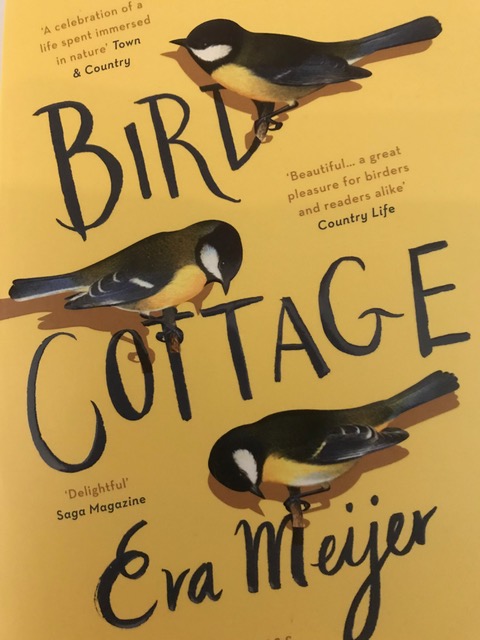
Review by Miles King. Miles works for People Need Nature, and writes about nature on his blog.
One of the unexpected bonuses of being a regular writer is that publishers’ PR agents send you books, for free, in the hope that they will be reviewed, perhaps even favourably. Even if that writing is only a blog! Or in my case, a blog, which morphed into a weekly column for Lush Times – though that column has now come to an end.
One such book arrived about a month ago – Bird Cottage by Eva Meijer. The book was published in Dutch in 2016, translated into English last year and published in paperback about a month ago. I felt duty bound to read Guy Shrubsole’s “Who Owns England” first, so this review is a little bit later than I had thought it would be. Given that the subject of the book, Gwendolen “Len” Howard, died in 1973, I hope the delay will be forgiven.
Meijer has written a fictionalised, or perhaps dramatized would be a more accurate word to use, account of Howard’s life. I had not heard of Len Howard before this book arrived, and that probably reflects the fact that my passion for nature focuses more on plants than birds. Now I know much more about her, that she was a literary celebrity writing for a popular audience, about birds and their behaviour, after the Second World war. And that her approach to studying birds was rejected by the scientific establishment, which, if the author is to be believed, was a source of great regret, and perhaps some resentment to Howard.
The story follows Howard through her life, from a young girl leading a privileged, though unhappy, upbringing in Edwardian Wales; through her career as a distinguished concert violinist in London during the inter-war period, and ultimately to her near complete withdrawal from public life. After her father died and left her an inheritance she acquired a cottage and large garden in Sussex, to live almost as a hermit on the South Downs, to immerse herself in the world of birds, so she could study their behaviour in an almost unimaginably intimate way.
She encouraged birds, particularly Great Tits, into her cottage, where she hoped they would behave just as naturally around her, as they would in their normal every day lives. They nested in various within the cottage and in nest boxes in the garden. She gained their confidence to such an extent that they would perch on her hands while she tried to type, and even rested in her lap. The results of decades of close observational research is elegantly interweaved amongst the dramatized story by Meijer, by using quotations from Howard’s writing, particularly her writing about one special Great Tit called Star. Howard had a very close relationship with Star and had, if we are to accept the story without question, taught Star to count – up to 8. Howard, being an exceptionally gifted musician, was also able to differentiate between individuals by their songs, and different songs used by those individuals, even attempting to write them down using musical notation.
Meijer evokes Howard’s world, living with birds in a very intimate, sensitive and compassionate way. It’s also a testament to the skill of the translator, Antoinette Fawcett, that this survived the process of translation so successfully. The book is quite short and really enchanting, revealing the life of someone who chose to reject much of the trappings of human society, to the point of self-imposed physical hardship (during the hungry years of the Second World War she sought out butter from local farms to feed her beloved birds, not for herself) as well as discouraging visitors to her cottage with numerous signs (especially after she became something of a celebrity when her writings were published).
The book left me wondering whether others had sought to repeat her approach, or perhaps had been put off by the way mainstream science rejected it as insufficiently “objective”. It would be interesting to know what Professor John Krebs, who started his distinguished scientific career studying Great Tits at Wytham Woods near Oxford, thinks of Howard’s work.
Bird Cottage by Eva Meijer (translated by Antoinette Fawcett) is published by Pushkin Press.
Inglorious: conflict in the uplands by Mark Avery is published by Bloomsbury – for reviews see here.
Remarkable Birds by Mark Avery is published by Thames and Hudson – for reviews see here.
[registration_form]
When I was a child my parents had a copy of Len Howard’s ‘Birds as Individuals’ and I remember being fascinated by the photos of the great tits living freely within her home. Unorthodox eccentric she may have been but it is nice to know that Howard has not simply been forgotten.
I’d forgotten about Len Howard but I’ve just found my copy of “Birds as individuals” which I was given as a child. Thanks for that ,now I’ll read it again. Great photos ,especially a couple where the bird that she is drawing with a dip pen is sitting on her hand as she draws it. The photos were taken by Eric Hosking (and the foreword is by Julian Huxley).
While looking for the book I came across 2 others from that time that both mention her :- “A place for animals” by Garth Christian (a call for the establishment of nature sanctuaries) and “Taming and handling animals” by Maxwell Night (who apart from being a naturalist was a spymaster and Ian Fleming’s model for M in the Bond books)
Funny old world isn’t it.
fascinating connection – Maxwell Knight is a major character in Robert Hutton’s excellent Agent Jack, the story of how MI5 ran a network of Nazi spies in Britain during WW2.